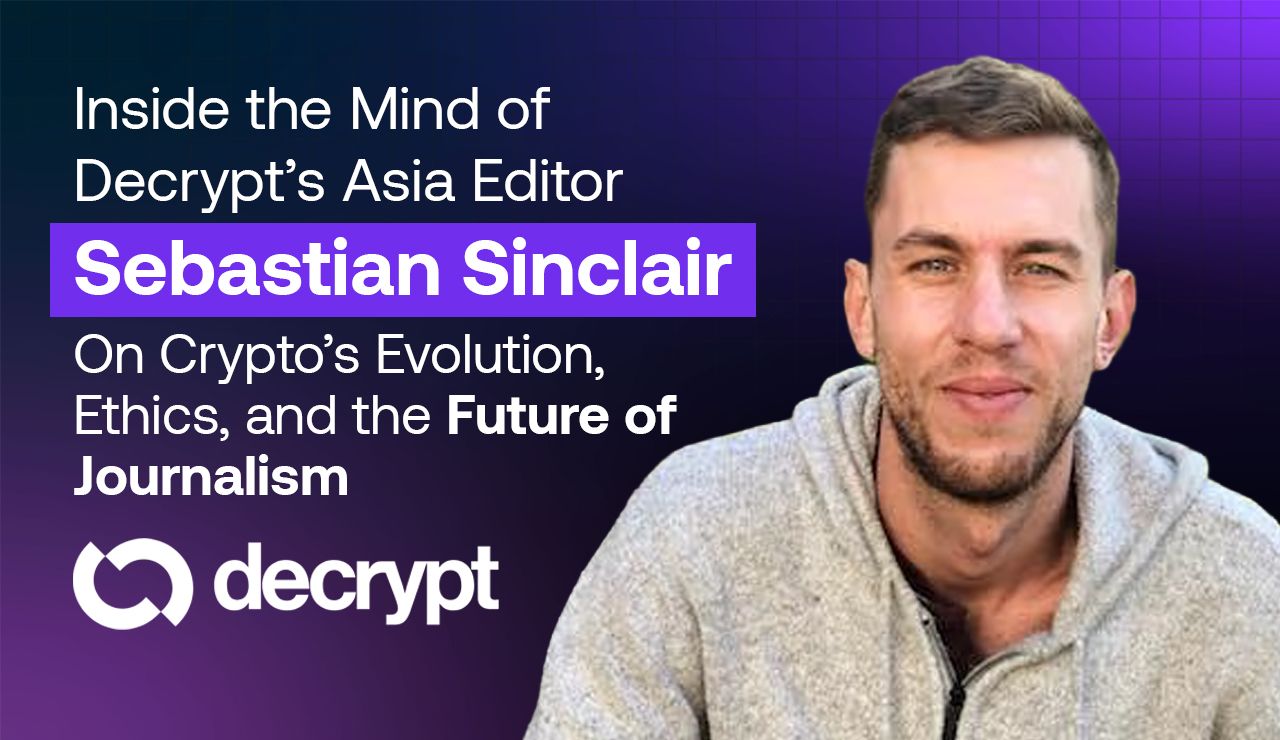
In the fast-evolving world of Web3 journalism, few names have charted a course as distinctive as Sebastian Sinclair, Asia Editor at Decrypt. From trading crypto in 2017 with $500 to leading one of the most influential editorial teams in the region, Sinclair’s story is a testament to resilience, curiosity, and the relentless pursuit of clarity in an industry built on complexity.
“I started trading at the height of 2017 thinking I could get rich quick—and failed miserably,” Sinclair recalls with a wry laugh. “After that, I thought I was done with crypto until I saw a CoinDesk job ad on Twitter. The rest unfolded naturally.”
What began as a personal experiment in trading turned into a career-defining journey through the leading newsrooms of CoinDesk, Blockworks, and now Decrypt, where Sinclair oversees a growing team of reporters covering the pulse of Asia’s crypto landscape.
After writing thousands of articles across markets, NFTs, DeFi, and blockchain policy, Sinclair felt the pull toward editing—a transition he now describes as both liberating and fulfilling.
“I’ve had my time in the spotlight. Now, I want to give others their byline,” he says. “I enjoy guiding writers, shaping narratives, and helping them find the angle that moves the story forward.”
Editing also allows him to steer the direction of coverage across a region that often remains underrepresented in global crypto media. “Asia has some of the fastest-growing startups and adoption rates, yet it’s often the ‘silent partner’ compared to the U.S. and Europe,” he notes. “There are stories here that deserve to be told.”
Sinclair’s work places him at the heart of one of the most dynamic markets in the world. He cites Indonesia, Thailand, and Cambodia as standout examples of innovation—regions where blockchain isn’t just a speculative tool, but a lifeline for financial inclusion.
“We recently covered a story about students in the Philippines using decentralized lending platforms to fund their education,” he explains. “It’s an example of how blockchain can serve the underserved—stories like that are powerful because they show real-world impact.”
Yet with rapid growth comes risk. “Asia’s diversity makes it exciting but also challenging,” he says. “Every jurisdiction—from Singapore to Japan—has different rules. You have to stay alert and avoid mixing policies when reporting, otherwise you risk misleading readers.”
Asked how investors can navigate Asia’s evolving landscape, Sinclair emphasizes one thing: due diligence. “Always check if it’s licensed, regulated, and compliant,” he advises. “Asia has its share of scams, so education is key. Regulation will mature, but until then, awareness is our first line of defense.”
He’s also optimistic about institutional capital entering the market, but with cautious realism. “We’ve seen ETFs and digital asset treasuries reshape the market, but they bring their own regulatory grey zones. It’s promising, but not without risk.”
Sinclair’s editorial ethos is rooted in impartiality—a principle he believes must anchor crypto journalism. He no longer holds significant crypto assets, a decision he views as essential to maintaining integrity.
“It’s important to experiment with crypto to understand it,” he admits. “But holding significant amounts while reporting? That’s a conflict unless disclosed. Transparency is key.”
Decrypt’s public disclosure policy on journalists’ holdings, he adds, helps reinforce trust between media and readers. “It’s about accountability. People deserve to know the potential biases behind what they read.”
When asked how he decides what makes a story, Sinclair’s rule is simple: “Does it move the market?”
If not, it might still be worth telling—but at the right time, and in the right format.
“There’s a difference between breaking news and deeper storytelling. A good editor knows which is which,” he explains. “Journalists get flooded with PR pitches, but our job is to filter, fact-check, and find meaning beyond the press release.”
One recent investigation illustrates his approach. A loan platform in the Philippines was pitched to Decrypt as offering “low-interest” loans. Upon closer inspection, the team found the rates were higher than comparable markets in the West.
“If we hadn’t dug deeper, we’d have just echoed their marketing narrative,” he says. “Journalism isn’t about printing what’s said—it’s about finding out what’s true.”
Covering crypto often means translating technical jargon into stories the average reader can understand—a skill Sinclair has honed through years of experience.
“Write for the stupidest person in the room,” he says bluntly. “Not to insult anyone, but to remind yourself that clarity is a service. If someone leaves your article feeling smarter, you’ve done your job.”
He adds that even seasoned reporters must continually re-learn. “Crypto changes so fast. I still look things up daily. To educate others, you have to keep educating yourself.”
As AI becomes increasingly capable of generating news, Sinclair believes the only defense for journalists lies in human connection.
“When LLMs start writing stories, the only edge humans will have left is our sourcing,” he says. “Network hard, get the story first, and build relationships AI can’t replicate.”
Yet his concern is real. “Governments aren’t ready for what’s coming. Innovation without regulation is dangerous,” he cautions. “We may be building something we can’t control.”
Still, Sinclair remains hopeful—and grounded. “Until AI grows legs and starts attending conferences, journalists still have the advantage,” he laughs. “But if it does, I’m retiring to a beach in Koh Samui.”